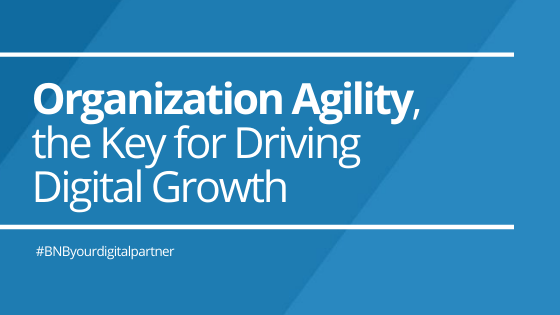Organization Agility, the Key for driving Digital Growth
In times where change is the new normal, organizations require new ways of working. Ways that are smarter, faster and more agile than ever before. Digital transformation is key to ensure that your organization is built for where the world is headed.
Findings from “Organizational Agility at Scale: The Key to Driving Digital Growth” (2019), a global study of 998 business leaders across industries, showed that the majority recognize the importance to their long- term success of driving digital growth. And, perhaps more tellingly, it was found that there is a strong relationship between digital revenue growth and organizational agility.
The Agile Organization
Being agile, according to McKinsey, is “the ability of an organization to renew itself, adapt, change quickly, and succeed in a rapidly changing, ambiguous, turbulent environment.” These abilities, supported by a culture committed to continuous innovation, where transformation is ongoing, are the central idea of organizational agility.
However, only 15% of the survey sample, who are called “leaders” have been able to unlock organizational agility fully, they are 10 times more likely than “laggards”, representing 55%, to react to shifts in the market with agility and speed.
Even though more than half of surveyed organizations are confident that, in the next three years, at least 50% of their revenue will come from digital streams, the majority of them will be unable to meet their high digital-growth expectations without taking steps to develop such agility. The good news is that the survey found five key best practices that drive to a truly agile organization.
Responsive
- Today’s businesses can’t wait 12 months to discover if a product or service is working, organizations that engage in active planning react faster to changing market conditions and potential threats to the business.
- Agile leaders plan in a continuous, real-time manner, which gives them the speed, agility, and dynamism they need to innovate successfully.
Adaptable
- Competitive organizations build fluid organizational structures and processes in order to have the ability to quickly realign their two most important assets: their people and their money, to match their changing needs.
Skilled
- A workforce with the right skills to deliver on digital plans and revenue streams is key. Leaders need to have plans to upskill the majority of their workforce and push specific initiatives to increase employee engagement.
Empowered
- Ultimately, it’s the workforce, bolstered by insights and machine learning, that will drive successful execution of digital business plans. Employees need to be empowered with the right information, at the right time, to make the best possible decisions for the business. Employees in leader organizations have access to timely and relevant data and are empowered to make appropriate decisions.
In control
- Being capable of acting in an agile and quick way doesn’t remove the need for robust, accurate, and timely measurement and control. Leaders must develop tools and metrics to measure the performance of digitally driven innovations to be able to quickly change course away from unsuccessful projects.
Learning from the leaders
Since the year 2000, 52% of companies in the Fortune 500 have either gone bankrupt, been acquired, or ceased to exist as a result of digital disruption. But leaders that have adopted the five key capabilities of organizational agility are significantly better placed for digital innovation success; but, what is the first step for business leaders looking to embrace organizational agility?
The most important, ensure to take the whole business with you; the shift to digital provides the opportunity to use technology to better align these functions and improve structural collaboration.
Ensure that the resources are used in the most effective way by ensuring quicker and more flexible planning, execution and evaluation.
Measure everything in order to track all the initiatives.
Sponsor collaboration, all aspects of the business must work hand-in-glove to build organizational agility across the enterprise. Underpinned by fluid processes, flexible structures, and robust technology capabilities, collaboration sharpens an organization’s ability to create fabulous customer outcomes.
In Closing
Businesses today face enormous pressure to deliver on digital transformation and exploit digital growth opportunities if they are to keep pace with competitors, they must rethink how their organization approaches technology and innovation before they fall too far behind.
Those who plan continuously; build adaptable and fluid organizations; upskill, inform, and empower their workforces; and put in place the right measurement and controls, will ensure continuous innovation and digital revenue growth. Businesses must embrace organizational agility to survive the digital storm and thrive in the age of continuous innovation.
References
Workday, Inc. (c2019). What’s the difference between today’s leaders and laggards?
Workday, Inc. (c2019). Organizational Agility at Scale: The Key to Driving Digital Growth.



